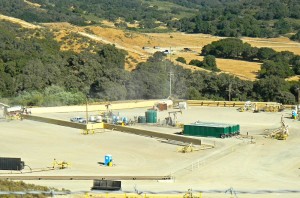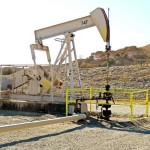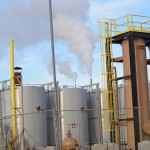
21
Jan, 2016
All Huff and No Puff?
Originally published by Mission and State and supported by a generous grant from the Knight Foundation.
This September, the County of Santa Barbara Planning Commission hopes to decide the fate of a final and contentious piece of the Environmental Impact Report currently holding up Santa Maria Energy’s proposed expansion into the 32-acre Careaga lease in the Orcutt oil field. The expansion could potentially yield up to 3,300 barrels a day and pump tons of emissions into the county’s air. How many tons, though, is a subject of a heated debate surrounding the EIR, the outcome of which is being closely watched by oil companies and environmentalists for what it says about how the county’s vast remaining oil reserves may be tapped.
 Santa Maria Energy’s plan has been held up since April 24 in a contentious and complicated EIR that planning commissioner Michael Cooney says is “the most complicated, difficult-to-understand document I’ve yet seen produced by this county.”
Santa Maria Energy’s plan has been held up since April 24 in a contentious and complicated EIR that planning commissioner Michael Cooney says is “the most complicated, difficult-to-understand document I’ve yet seen produced by this county.”
“It’s incredible,” said Cooney during the April commission meeting. “I do think it’s going to take an effort for this commission to understand this document much less the public.” [Full disclosure: Cooney sits on Mission and State’s advisory board].
The issue is over what level of greenhouse emissions reductions the expansion will be held to. Greenhouse gas emissions can include carbon dioxide, methane, nitrous oxide and ozone. Once upon a time a project like this might have gone through various stages of the approval process without much public scrutiny, but ever since AB 32, the so-called Global Warming Solutions Act, the days of big emissions projects being quietly approved by the county are over.
Former Gov. Schwarzenegger surprised both friends and foes in 2006 by signing into law AB 32, which mandates bringing emissions to 1990 levels by the year 2020. It took years for the state’s Air Resources Board, charged with regulating pollution, to hash out what combination of regulation, mandatory caps and market mechanisms would get the job done, but the law finally went into effect in January 2012 and now the county planning commission and Environmental Impact Report must toe the line.
Moreover, Schwarzenegger signed S-3-05 in 2005, an executive order to bring emissions down to 80 percent below 1990 levels by the year 2050. The planning commission must consider AB 32′s immediately mandated cuts as well as S-3-05, given the longterm nature of Santa Maria Energy’s proposed drilling.
At risk is Santa Maria Energy’s expansion into the Careaga oil lease behind the White Hills Vineyard off Highway 135 in Orcutt. This field is a modest but significant play in the fossil-fuel boom sweeping the nation—a boom that has been made possible by technologies that can extract once-hard-to-get oil. In this case, it’s heavy crude oil trapped in diatomaceous sedimentary rock. The oil must be steam-heated to 550 degrees to get the thick substance up and out of the ground.
If its plans are approved, Santa Maria Energy will build 110 new wells to add to its existing 26. The new wells will feature tandem pumps: one to drill for the oil and another to heat it for extraction. The process is called cyclic steaming, but the industry calls it “huff and puff.”
It’s an old and effective method made new by improved steaming solutions and drills that can go deeper. Generators pump steam through a web of pipes into wells. At 1,000 feet underneath the surface, the steam melts the heavy oil and allows it to hemorrhage out. After the drilling and steaming are done, the liquid water waste used in the drilling process is re-injected back into the earth. Santa Maria Energy also found a way to slant drill so that more pumps could be put side by side—more wells on less space.
Compared to breaking up the earth by fracking or ripping deep-water drilling, steamed water can seem innocuous. The problem, though, is that huff and puff takes a lot of energy to do and creates tons of emissions, and therefore can run afoul of AB 32.
Any project with more than 10,000 metric tons of emissions is subject to AB 32. At peak production, this project could emit 87,874 metric tons of greenhouse gases a year, if unmitigated. Theoretically, this thick, Orcutt Hills huff-and-puff project could become the largest emissions-generating operation the county has ever seen. Santa Maria Energy claims it can tap the diatomite at its drill tips for the next 50 years. This would significantly add to the county’s oil production, currently at 3.4 million barrels a year. Companies eager to get at Santa Barbara’s remain reserves are keeping a keen eye on which way Santa Maria Energy’s EIR battle goes.
Santa Maria Energy President David Pratt isn’t happy about the EIR holdups. So much so that he recently accused members of the county planning commission of bowing to special interests.
Adding to the drama, the Air Pollution Control District, which plays a pivotal role in steering the emissions-reductions negotiations, put one of its own in the crosshairs for entanglements with Santa Maria Energy. Lompoc city councilmember Ashley Costa holds a seat on the regulatory organization and also happened to be on Santa Maria Energy’s payroll as a public relations flack. Fellow APCD board members accuse Costa of pushing new emission allowances that could benefit local oil companies, including Santa Maria Energy.
Costa is under state investigation for possible conflict of interests after County of Santa Barbara Supervisor Salud Carbajal first learned of her possibly too-diverse resume in a Mission and State article last month. Costa has left Santa Maria Energy since the conflict-of-interest investigation.
All the drama is subtext and subplot to the real issue: playing the percentages.
AB 32 requires a 16 percent reduction in emissions for all new projects. The emissions reductions can come through an energy company lowering its across-the-board emissions or through mitigating big projects such as Santa Maria Energy’s Careaga field expansion. The 16 percent figure is based on modeling that predicts what a project’s emissions would have been without AB 32 mandated reductions.
For its part, Santa Maria Energy is coming to the table with a 29 percent reduction offer. “That’s twice what we are required,” says Bob Poole, Santa Maria Energy’s public and government affairs manager. Poole says Santa Maria Energy won’t budge higher than 29 percent.
That’s not good enough for local environmental groups, who are holding out for a 90 percent emissions reduction. The Environmental Defense Center, Community Environmental Council and Santa Barbara County Action Network think the oil company can reach these levels by reducing its total emissions and by employing various offset strategies to mitigate the expansion project’s impacts.
With the oil company and the environmentalists holding fast, the planning commission voted 3-2 against Santa Maria Energy’s proposed 29 percent reduction on April 24, with Cooney, Cecilia Brown and Joan Hartmann casting the decisive votes. The commission, juggling AB 32′s mandated cuts along with S-3-05′s pressure for even greater future reductions, added a compromise 50 percent emissions-reduction proposal to the EIR and sent it back for public comment.
The delays put Pratt in a foul mood. Pratt characterized the 90 percent reduction request as “borderline improper” in a letter to the Central County Coalition, a business and property-owners organization formed last year to promote the interests of, yes, business and property owners.
Companies eager to get at Santa Barbara’s remain reserves are keeping a keen eye on which way Santa Maria Energy’s EIR battle goes.
Pratt went on to say that “county staff will continue to be bullied by non-elected and non-governmental third parties and [the] county will continue to suffer the consequences until all of [those] who believe in being good neighbors and applying the Golden Rule stand together.”
Pratt and Santa Maria Energy have a lot at stake in the languishing EIR process. The company claims the delays in getting the expansion approved have seriously hurt its bottom line. In the first quarter of this year, the company reported a $1 million net lost. It let one of its loans default in January.
Santa Maria Energy recently added a ticker to its website to document how much money it says the extended EIR process has cost the company. It claims it loses $468,600 a day on potential profits and economic benefits, and that it has spent $2 million on the EIR. Total losses since the planning commission added its 50 percent reduction compromise to the EIR and sent it back for public comment is about $56 million, according to Santa Maria Energy.
Nathan Alley, an Environmental Defense Center lawyer, wonders if Santa Maria Energy’s financial problems could have been avoided. He questions why the company doesn’t just pay the estimated $700,000 to $800,000 a year at peak operation for emissions mitigation costs, a drop in the bucket if earnings on the new wells would be almost $500,000 a day.
“The company would pay less than a dollar per barrel for those credits,” says Alley.
For now, though, Santa Maria Energy remains on the offensive. In another letter to the Central County Coalition, an SME staffer says the planning commission’s proposed 50 percent emissions compromise is “a textbook case of regulatory fiat and arbitrary rulemaking.”
There’s not much chance huffing and puffing heavy oil out of the ground is going meet the emissions caps the planning commission and environmental groups are seeking. If Santa Maria Energy is ever going to make this project work, it’ll have to turn to so-called offsets to gain whatever percent emissions reductions are eventually agreed upon. Such offsets could put Santa Maria Energy into everything from recycling surplus natural gas to planting trees to even helping pay for green retrofits for small businesses. Now, it is just a matter of figuring what types and how many.
Santa Maria Energy also claims county staff urged the staff to contribute $500,000 over the next 10 years toward such environmental upgrades as solar panels and tank-less water heaters for local residents who might not otherwise be able to afford them. If such offset mitigations go through, this project may foretell how the county plans to keep the oil and attendant tax revenues flowing while maintaining its eco-friendly reputation.
The planning commission says it hopes to make its final decision on the Environmental Impact Report by the end of September.






You must be logged in to post a comment.